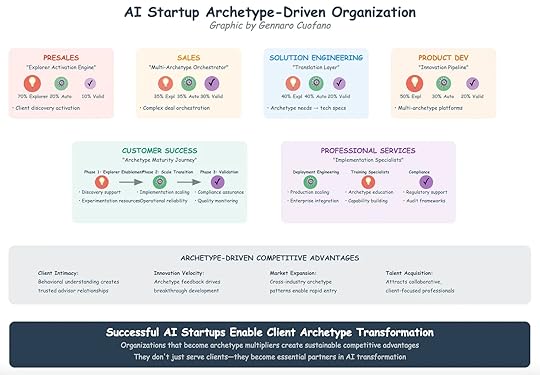The Archetype-Driven Organization: How AI Startups Build Enduring Advantage

AI startups don’t win by selling generic software. They win by embedding themselves into client archetypes—understanding not just what a client does but how they operate across maturity phases. Startups that organize around these archetypes build trust faster, accelerate innovation velocity, and capture market expansion opportunities that competitors miss.
This is the logic of the Archetype-Driven Organization.
From Generic Functions to Archetype MultipliersTraditional B2B organizations divide roles—presales, sales, engineering, product, services—into functional silos. Each function optimizes for efficiency, but often loses touch with how clients actually change over time.
An archetype-driven startup does the opposite. Every function aligns with client archetypes—Explorer, Automator, Validator—and acts as a multiplier. This creates resonance across the buyer journey, from initial curiosity to scaled adoption.
The result is an organization that doesn’t just sell tools—it enables client transformation.
Core Organizational FunctionsPresales: Explorer Activation EngineArchetype mix: 70% Explorer, 20% Automator, 10% ValidatorMission: Activate client discovery.How it works: Early-stage clients don’t know what’s possible. Presales teams guide them through exploration, providing experimentation resources and framing use cases. This creates momentum before procurement begins.Sales: Multi-Archetype OrchestratorArchetype mix: Balanced across Explorers, Automators, and Validators.Mission: Orchestrate complex deals across multiple archetypes.How it works: Modern AI deals span multiple stakeholders. Sales must translate across different archetypal logics—exploration (curiosity), automation (efficiency), and validation (compliance). The best sellers operate less like hunters and more like conductors.Solution Engineering: Translation LayerArchetype mix: 40% Explorer, 40% Automator, 20% Validator.Mission: Convert archetype needs into technical specifications.How it works: Clients often can’t articulate what they need in technical terms. Solution engineers act as translators—mapping domain-specific challenges into machine-readable architectures.Product Development: Innovation PipelineArchetype mix: 50% Explorer, 30% Automator, 20% Validator.Mission: Build platforms that serve multiple archetypes simultaneously.How it works: Product teams don’t just solve current needs. They monitor archetype feedback loops, using Explorer signals to push innovation, Automator feedback to drive usability, and Validator demands to ensure compliance. This makes product roadmaps more resilient.Customer Success: Archetype Maturity JourneyPhase 1: Explorer Enablement → Discovery support and experimentation.Phase 2: Scale Transition → Operational reliability and automation.Phase 3: Validation → Compliance assurance and quality monitoring.Mission: Guide customers through their archetype evolution.How it works: Success isn’t just renewals. It’s moving clients up the archetype ladder, embedding the startup deeper into their workflows as they scale.Professional Services: Implementation SpecialistsDeployment Engineering → Production scaling, enterprise integration.Training Specialists → Archetype education, capability building.Compliance → Regulatory support, audit frameworks.Mission: Close the gap between experimentation and enterprise readiness.How it works: Professional services ensure that clients don’t stall after pilots. By handling scaling, training, and compliance, they reduce friction and accelerate adoption.Archetype-Driven Competitive AdvantagesClient IntimacyArchetype awareness creates behavioral empathy.Teams become trusted advisors, not vendors.Innovation VelocityFeedback from archetypes drives continuous breakthrough development.Explorers signal emerging use cases before the market sees them.Market ExpansionArchetype patterns repeat across industries.Learnings from one vertical accelerate entry into another.Talent AcquisitionArchetype-driven organizations attract collaborative, client-focused professionals.Employees see themselves as partners in transformation, not just quota carriers.Why This MattersMost AI startups fail not because their technology is weak, but because they fail to integrate into client transformation journeys. They get stuck in pilot purgatory, unable to cross from exploration to enterprise-wide adoption.
The archetype-driven organization avoids this trap. It aligns every function around the client’s archetype journey. Instead of selling a point solution, it becomes the infrastructure for client maturity.
This alignment produces compounding advantages: higher trust, faster innovation, broader markets, and stickier adoption.
Conclusion: From Startup to Archetype MultiplierThe most successful AI startups don’t just close deals. They enable clients to evolve. They build archetype multipliers: presales teams that activate explorers, sales that orchestrate across archetypes, product teams that design multi-archetype platforms, and services that push clients toward maturity.
These startups don’t just serve clients. They become essential partners in transformation. In a world where AI is reshaping every industry, that’s the difference between a tool vendor and a category-defining company.

The post The Archetype-Driven Organization: How AI Startups Build Enduring Advantage appeared first on FourWeekMBA.



